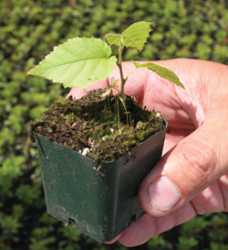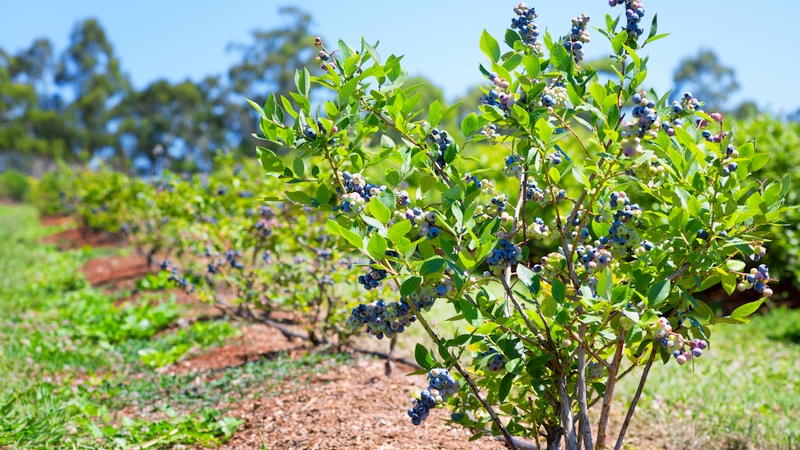Hazelnuts Making A Comeback

It may have been 38 years ago now, but Mike Wilhoit remembers it vividly. The executive vice president of Evergreen Agricultural Enterprises in McMinnville, OR, was then just a boy growing up in a hazelnut-growing family. Oregon State University had issued a bulletin about a new disease found in the area, Eastern filbert blight, and his grandmother had casually pinned it up on the bulletin board in the family room as she would any other announcement.
“We didn’t think anything of it; there are hazelnut trees over 100 years old that are still productive, and I thought they would live forever,” he recalls. “Now here we are all these years later …”
Oregon growers have been battling Eastern filbert blight ever since. Incidentally, the terms “filbert” and “hazelnut” are interchangeable. While growers refer to filberts, they are known internationally as hazelnuts, and that’s the term marketers use, which is why hazelnut has become the term used widely today.
Eastern filbert blight is deadly. Back in those early 70s, for instance, there was a thriving little hazelnut industry in and around Vancouver, WA, that was pretty much wiped out by the disease, says Wilhoit. Growers wearied of fighting the disease, and partly because of that the hazelnut acreage in Oregon — which produces 99% of the nation’s crop — stayed flat at 26,800 acres from 1995 to 2005. But now that’s changing.
Not For All Growers
As any fruit or nut grower can attest, this business is a lot easier if you can differentiate yourself from the pack. Whether by producing a club variety, or through a catchy marketing strategy, a grower’s better off by creating some distance from other producers. The key is figuring out what you have, or can obtain, that will allow you to differentiate you and/or your products.
At Evergreen Agricultural Enterprises, they realized that their edge was the strong capital backing provided by their parent company, Evergreen International Aviation. Quite simply, they have resources that most growers can only dream of. “We want to get into crops that have a higher barrier of entry,” says Mike Wilhoit, the ag division’s executive vice president. Wilhoit’s only been with Evergreen for nine years, but he was raised in the business, a sixth-generation Oregon grower who’s been farming hazelnuts for 38 years.
The largest capital cost is land, especially in the Willamette Valley where housing pressures have driven the average per-acre price up to about $10,000. Growing hazelnuts requires a relatively large amount of land, and that made the crop an obvious choice when combined with the fact that the valley’s about the only good place in the U.S. to grow hazelnuts. It’s at the right latitude, for one thing. Most hazelnuts around the world are grown at about 30 to 45 degrees, with Turkey being by far the largest producer, followed by Italy and then Oregon.
It’s Just Right
Hazelnuts are also grown, like almonds to the south in California, near a very large body of water that regulates the climate, says Wilhoit. But unlike almonds, hazelnuts can’t take warm bloom time temperatures. When they bloom, from December through February when the orchards turn a vivid yellow, the temperatures are only in the 40s during the day. If it were warmer, Wilhoit says the pollen could ripen and be gone, and the wind-pollenated trees would be bereft of pollen.
Incidentally, because it must be cool enough for the pollen to remain available for three months at bloom, some growers have looked into planting hazelnuts in cooler climates. But Wilhoit says it seems the European varieties they grow in Oregon can’t take it too much cooler. Other hazelnut varieties grow quite well in cooler temperatures, but they produce scrawny nuts that aren’t commercially acceptable.
Aided by modern breeding techniques, Oregon State University breeders have come up with varieties in recent years with more resistance to the disease. The first two they developed, released about 10 years ago, were “Lewis” and “Clark.” They were named after the famous pioneers of the Oregon Trail because they were the first hazelnut varieties developed in the U.S. Other varieties with even greater resistance, “Santiam” and “Sacagawea,” have followed.
The new varieties have had a profound effect on the industry, says Polly Owen, the manager of the Hazelnut Marketing Board. By 2007, acreage was finally climbing upward, to 28,100. The statistics for 2008 came out just a month ago, says Owen, and they showed a healthy increase of 2,000 acres, for a total of 30,100 acres. “We’re on the increase again, which is a wonderful thing,” she says. “We’ve been waiting for this.”
Evergreen, the state’s largest grower, has played no small part. This past year they planted 250 acres of four of the newer varieties. Besides Santiam and Sacagawea, they planted two still-numbered varieties, 688.010 and 703.007. The latter is scheduled to be released as “Jefferson,” but that announcement had not yet been made at press time.
Wilhoit, whose family has deep roots in the industry — his son Henry is a seventh-generation grower — couldn’t be more pleased. The new varieties are not only more resistant to the deadly blight, but they are much more precocious. Older varieties often don’t produce a crop until their seventh leaf, but Wilhoit harvested a small crop from a Clark block this past fall in just its third leaf. “A few years ago this industry was really down,” he says. “Now we have new outlook on life.”
Home Of The Goose
Paying a visit to Evergreen Agricultural Enterprises is a little different from meeting with most growers. It’s in a relatively bucolic area, McMinnville, OR, but as you approach the headquarters, two 13-story buildings suddenly appear with an IMAX theater in between. The buildings tower over the valley, and at first look wildly out of place. But then you take a closer look and realize that it’s really quite necessary because a building has to be that big if it’s going to house the world-famous aircraft, the Spruce Goose.
That’s right, the gigantic flying boat — it has a wingspan of 320 feet — is now housed in one of the large buildings, the Evergreen Aviation Museum. The other building is the space museum. The legendary Howard Hughes designed the plane as a solution to the German U-Boat threat in World War II, but it flew only once, on Nov. 2, 1947. In 1992, Mike Smith, the son of the founder of Evergreen International Aviation, Del Smith, won custody of the Hughes Flying Boat. Mike Smith was tragically killed in an car accident three years later, and a statue of him can be found in front of the museum.
The plane, which had been on display next to the Queen Mary in Long Beach, CA, was disassembled and moved by barge, train, and truck to McMinnville. Between 1992 and 2000, the massive parts underwent preservation and restoration by volunteers while plans were made for its new hangar. That new hangar, now the museum, now hosts 300,000 curious visitors each year, says Mike Wilhoit, the ag division’s executive vice president.
It’s a real asset for the ag division, because they were able to open tasting rooms in both the aviation and space museums, says Wilhoit, where visitors can sip such wines as a “Spruce Goose Oregon Pinot Noir.” They grow all the grapes for the wines, bottling almost half of their crop and selling the rest. “Our goal is to put it all in the bottle,” he says.
And why not? After all, they’ve got a beautiful synergy going on with the museums that gives them quite a marketing edge. “A lot of the wineries in Oregon are small, and while many of them do have tasting rooms, they don’t have the Spruce Goose,” he says. “It’s one of a kind.”









